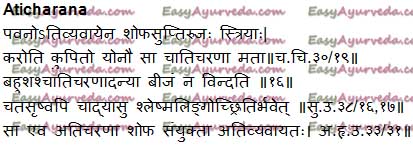Aticharana – Symptoms, Pathology, Treatment
By Dr Raghuram Y.S. MD (Ay) & Dr Manasa, B.A.M.S
Aticharana is one among the 20 gynaecological disorders caused due to
excessive sexual indulgence by a woman.
Table of Contents
Causes, pathology
Etiological factors
Ati = excessive
Charana = activity, copulation in this context
Thus, a gynaecological disorder caused due to excessive copulation is called aticharan.
Read – Gynecological Disorders Causes, Types As Per Ayurveda
Pathogenesis
1. When woman gets excessively involved in sexual act, vata gets aggravated. This aggravated vata afflicts the reproductive system of the woman and causes pain, inflammation and numbness. This pathological gynaecological condition is called aticharan. (Ref – Charaka)
2. Vatiki yoni i.e. gynaecological disorder caused due to vitiation of vata, when gets inflamed due to excessive indulgence in coitus, causes aticharan gynaecological disorder. (Ref – Vagbhata)
Read – Vatala Yoni Vyapad – Causes, Symptoms, Treatment
Symptoms, Sanskrit verse
Symptoms
- Yoni Shopha – swelling / inflammation in the vagina / uterus (Cha.Chi.30/19)
- Yoni Supti – insensibility in the reproductive organs (Cha.Chi.30/19)
- Yoni Ruja – pain in reproductive organs (Cha.Chi.30/19)
- Na beejam garbha ankura jananam – the woman does not achieve conception (Dalhana, SulU.38/16)
- Shleshma linga – presence of other kapha symptoms such as itching, stickiness, unctuousness etc in vagina and uterus (Su.U.38/16, 17)
- Atirichyate / rajo munchite atyartham – woman discharges raja repeatedly before the ejaculation of male partner, here raja depicts early orgasm in comparison to male partner (Bh.Pr.70/12)
Read – Comparative Study Of PID With Yoni Vyapath

Correlation
Modern correlation and comparative study
According to Charaka and Vagbhata, aticharanam gynaecological disorder is predominantly caused by vitiated vata. On the other hand, Sushruta opines that it is caused due to vitiated kapha. In spite of this, none of the authors have given different names for this condition and have stuck to the same name, i.e. aticharana. As a result we can see difference in signs and symptoms given by these authors while all authors are on common agreement that chief etiological factor for manifestation of aticharana is excessive indulgence in sexual act.
Read – Vaginitis: Ayurvedic Treatment, Medicines, Home Remedies
We can categorise the symptoms explained by Charaka / Vagbhata and Sushruta into two stages and try to understand this condition from different viewpoints.
Initial stage belongs to Sushruta’s explanation. In this stage due to intense sexual desire, woman may feel vaginal itching. Due to repeated coitus there may occur excessive sticky secretions from cervical and endometrial glands. These are similar to the symptoms of increased kapha as explained by Sushruta.
Later stage belongs to Charaka / Vagbhata’s explanation. In later stages of excessive coitus, there may be severe pain in the genital tract, mainly in the vagina and uterus associated with hyperemia and inflammation etc. These are similar to symptoms of increased vata as explained by Charaka / Vagbhata.
Read – Vaginal White Discharge (Leucorrhea) Ayurvedic Treatment, Home Remedies
Aticharana gynaecological disorder can be compared to –
- Vaginal inflammation due to excessive coitus associated with infertility
- Sexual incompatibility, specially due to psychological weakness of woman (Bhava Prakasha)
Treatment
Treatment of Aticharana gynaecological disorder
Uttara Basti – Oil prepared with Jeevaniya group of herbs should be used for administering vaginal enema.
Anuvasana / Asthapana Vasti – Unctuous enemas should be given using vataghna taila and shatapaka oils. Decoction enemas also should be given alternatively.
Swedana – Sudation treatment with vata mitigating herbs should be administered.
Ahara and Upanaha – Foods and poultices including unctuous and vata alleviating substances should be included in treatment protocol
Click to Consult Dr Raghuram Y.S. MD (Ayu) – Email / Skype









